 Crime
Crime  Crime
Crime  Technology
Technology 10 Hilariously Over-Engineered Solutions to Simple Problems
 Miscellaneous
Miscellaneous 10 Ironic News Stories Straight out of an Alanis Morissette Song
 Politics
Politics 10 Lesser-Known Far-Right Groups of the 21st Century
 History
History Ten Revealing Facts about Daily Domestic Life in the Old West
 Weird Stuff
Weird Stuff 10 Everyday Products Surprisingly Made by Inmates
 Movies and TV
Movies and TV 10 Actors Dragged out of Retirement for One Key Role
 Creepy
Creepy 10 Lesser-Known Shapeshifter Legends from Around the World
 Animals
Animals 10 Amazing Animal Tales from the Ancient World
 Gaming
Gaming 10 Game Characters Everyone Hated Playing
 Crime
Crime 10 Terrifying Serial Killers from Centuries Ago
 Technology
Technology 10 Hilariously Over-Engineered Solutions to Simple Problems
 Miscellaneous
Miscellaneous 10 Ironic News Stories Straight out of an Alanis Morissette Song
Who's Behind Listverse?

Jamie Frater
Head Editor
Jamie founded Listverse due to an insatiable desire to share fascinating, obscure, and bizarre facts. He has been a guest speaker on numerous national radio and television stations and is a five time published author.
More About Us Politics
Politics 10 Lesser-Known Far-Right Groups of the 21st Century
 History
History Ten Revealing Facts about Daily Domestic Life in the Old West
 Weird Stuff
Weird Stuff 10 Everyday Products Surprisingly Made by Inmates
 Movies and TV
Movies and TV 10 Actors Dragged out of Retirement for One Key Role
 Creepy
Creepy 10 Lesser-Known Shapeshifter Legends from Around the World
 Animals
Animals 10 Amazing Animal Tales from the Ancient World
 Gaming
Gaming 10 Game Characters Everyone Hated Playing
10 Reasons Snakes Are Even Creepier Than You Thought
We all know snakes aren’t evil, but a lot of people find them incredibly creepy. Thanks to their tongues, teeth, and legless bodies, serpents are often portrayed as villains in bad Syfy movies and novels featuring noseless wizards. True, snakes keep the rodent population under control, but due to eerie facts like these, plenty of people still think they’re awfully freaky.
10Snake House

Ben and Amber Sessions thought they were getting a great deal. Their five-bedroom house in the country cost only $180,000. If only they’d watched more horror movies, they would’ve known something was up, especially once the realtor started talking about the “previous family.”
Evidently, that family hadn’t wanted to pay their mortgage, so they’d made up a tall tale about a snake infestation. Of course, it was totally untrue, the real estate agent assured Ben and Amber. Happy to get such a great house, the Sessions signed a paper acknowledging the crazy serpent story and found themselves the owners of a new house. Then their lives turned into a nightmare.
It started when Amber found eight garter snakes slithering around the house. Soon, the snakes were popping up everywhere. They were swimming in their well, releasing a musk that tainted the water. Sometimes, so many congregated in the yard that the ground looked alive. Even worse, when the Sessions went to sleep, they were serenaded with the sound of hundreds of garter snakes crawling through the walls.
Unknowingly, the Sessions had moved into a house built on top of a hibernaculum, which is a hangout where snakes sleep during the winter. Once things warmed up, the creatures awoke and invaded the Sessions’ new home.
The family was in no real danger. Garter snakes are only mildly venomous and can’t harm humans. Still, there’s something inherently revolting about sharing a house with innumerable reptiles. As Amber put it, “It felt like we were living in Satan’s lair.”
The couple declared bankruptcy and moved out as fast as they could.
Read more fascinating facts about snakes with The New Encyclopedia of Snakes at Amazon.com!
9The Snake That Steals Poison From Toads

There’s a difference between poison and venom. Sure, they’ll both kill you, but venom is injected through a bite or sting, while poison has to be swallowed or inhaled.
Now let’s focus on the tiger keelback. Unlike cobras or mambas, this Japanese serpent is non-venomous. If it bites you, it’ll hurt, but you could shake it off and just walk away. But while the tiger keelback lacks fangs, it does pack two glands brimming with poison on the back of its neck. These nuchal glands release toxins called “bufadienolides,” which attack the heart and make breathing difficult. However, the keelback can’t actually produce poison. So where are these chemicals coming from?
Tiger keelbacks love chowing down on toads, and these warty amphibians have glands overflowing with bufadienolides. When snakes pig out on a bowlful of toxic toads, they load up on poison to fight off predators. Their bodies then modify the poisons to make them even more powerful.
These supercharged substances give the snakes a confidence boost, so chances are slim that they’ll back down from a fight. If you ever see one of these guys slithering across your path, don’t pick it up.
8Virgin Births

Scientists have known for some time that female vertebrates don’t always need males to conceive. This process is called facultative parthenogenesis, and chickens, turkeys, sharks, and Komodo dragons are all able to reproduce without male assistance. But all those animals have been observed in captivity. No one had ever found a vertebrate virgin birth in the wild until 2012, when scientists studying the spawn of North American cottonmouths and copperheads found that 2.5–5 percent of all pit viper litters were born without fathers.
While scientists aren’t exactly sure what causes facultative parthenogenesis to occur in wild vipers, they know the process starts with meiosis. That’s the phase of sexual reproduction when sex cells divide in two halves, each with half of the chromosomes needed to create a new snake. Usually, these haploid cells need input from the father, but in bizarre cases, the mother’s cells merge with each other and create future serpents.
For the most part, scientists think these virgin birth babies are sterile, but in 2012, one researcher claimed he found a garter snake that gave birth to fertile offspring.
7Boas Sense Your Heartbeat

Occasionally reaching 5.5 meters (18 ft), boa constrictors are some of the most affectionate animals on the planet. All they want to do is hug you—to death. While they don’t eat people, they have been known to cuddle with humans from time to time.
Once a boa wraps you up, there’s no way you can play possum and hope the snake lets you go. While you might close your eyes and hold your breath, the constrictor isn’t fooled. It can feel your heart beat.
Researchers from Dickinson College stuck simulated hearts into dead rats and gave the rodents to hungry snakes. The fake hearts were connected to a pump that scientists controlled from a distance, and they varied the amount of time the hearts beat from feeding to feeding. Boas let go sooner if the heart wasn’t beating at all. And if the heart pumped for longer than 20 minutes, they actually gave up. Since they could feel the organ beating away seemingly endlessly, they figured it wasn’t worth spending so much energy on such a scrappy rat.
6The Disease That Makes Snakes Tie Themselves In Knots
Without a doubt, the two scariest words in the English language are “new virus.” Whenever scientists discover one of these infectious agents, there’s always a chance it might start a global pandemic of Stephen King proportions.
And humans aren’t the only creatures that worry about the viral apocalypse. In 2009, snakes at the Steinhart Aquarium in California were hit with a mysterious virus that scientists had never seen before. While the new pathogen didn’t turn the serpents into killer rage monsters or cause their flesh to fall off their bones, the symptoms were nearly as disturbing.
Boas and pythons infected with this deadly virus suffer from a debilitating illness called “inclusion body disease.” In the first stage of this sickness, the snake vomits uncontrollably. Next, it starts acting like it’s had too many drinks, swaying back and forth, flipping over on its back, and staring at the sky like it’s watching the stars. And then things get really gross. The snake crawls over its own body, back and forth, until it’s tied itself into one big knot that it can’t undo.
The disease is caused by an arenavirus, an agent distantly related to the pathogen that causes Ebola. The arenavirus attacks the brain, making the snake work itself into the world’s most horrifying bow. There’s no cure for inclusion body disease, and any snake that gets infected has to be put down. The only silver lining here is humans can’t contract the same affliction, which is great news, as the results wouldn’t be pretty.
5The Tribe Of Giant Snake Victims

In 1962, anthropologist Thomas Headland moved to Luzon, the largest island in the Philippines, setting up camp with the Agta people. While moviegoers watched Lawrence of Arabia, Rachel Carson published Silent Spring, and the world focused on the Cuban Missile Crisis, the Agta were living like ancient hunter-gatherers in the Filipino rainforests.
They were also at war with the local snake population. A quarter of the men had been attacked by reticulated pythons. The longest snake in the world, this creature can grow to over 7 meters (23 ft) and can weigh over 75 kilograms (165 lb). Compare that to the average Agta, who stands less than 150 centimeters (5′) and rarely weighs as much as an American 13-year-old.
Since they were small, lived in the jungle, and competed with pythons over food, the Agta often came to blows with these giant snakes. Out of 120 interviewees, Headland found 26 percent of the men had encountered angry pythons, and many bore the scars to back up their claims. Between the 1940s and 1970s, six people were killed by these snakes, including two kids who were gobbled up on the same night.
The Agta didn’t just sit back and let these serpents slither all over them. Every single man had killed at least one python in his life—or so each claimed, at least. The men regularly went around armed with guns and machetes. The father of the kids who were eaten stabbed the python responsible to death.
There aren’t as many “man vs. snake” battles on Luzon today. Thanks to encroaching modernization, the Agta have largely given up their old way of life. Since they’re no longer living in the middle of snake country, the attack rates have dropped dramatically. But the reticulated pythons are still out there, hunting in the jungle, so if you ever visit Luzon, stick to the cities.
4The Cobra Village
While the Agta people weren’t fond of snakes, things are totally different in Ban Kok Sa Nga. Located in northeastern Thailand, this community takes its passion for serpents to a dangerous extreme.
This reptilian love affair started back in the 1950s when a doctor wanted to put his sleepy little town on the map. This physician convinced everyone in town to breed snakes and put on cobra shows.
If you visit Ban Kok Sa Nga today, you’ll find around 140 houses, and outside almost every home, you’ll notice at least one wooden crate. Open up that box, and you’ll find something long, legless, and in a bad mood.
Ban Kok Sa Nga is full of all sorts of cobras and constrictors, some of whom star in the village’s serpentine circus. During a performance, visitors might witness a cobra boxing match where handlers tease the snakes, kick at their heads, and dodge their bites. They might even see someone shove a cobra in their mouth.
Despite their rough treatment, the folks at Ban Kok Sa Nga really love their snakes. In fact, they breed more cobras than needed for the show simply because they like them as pets. Snakes are such a way of life that children are taught to handle them from a young age, and whenever a cobra dies, its owners make an offering for the snake at the local temple.
These irresponsible relationships often lead to accidents. One septuagenarian handler, Bualee Chai, has been bitten at least 21 times. But while he’s missing a few fingers, he’s pulled through each time thanks to an herb known as wan paya ngoo.
Learn to recognize and identify snakes in your own neck of the woods with A Field Guide to Reptiles and Amphibians at Amazon.com!
3Military Weapons

They say war is hell. That applies doubly when snakes are involved. While bullets and bombs do far more damage, serpents are excellent psychological weapons. Nobody wants to end up with a pair of fangs in their foot.
Perhaps the most famous example of reptilian tactics took place during the Vietnam War, down in the Cu Chi tunnels. Spanning over 240 kilometers (150 mi), this underground labyrinth let the Viet Cong travel undetected by enemy helicopters. But while they were safe from aerial attack, they had to worry about gutsy American troops (“tunnel rats”) who’d crawl through the dark in search of the enemy. To make things difficult for their foreign foes, the Viet Cong loaded the tunnels with bamboo vipers.
These serpents were nicknamed “one-step” or “two-step” snakes because, if you were bitten, that’s how many steps you’d take before you dropped over dead. These vipers were placed inside hollowed-out bamboo sticks, so when a tunnel rat knocked one over, the snake would slither out and strike at his face. While death by snakebite was extremely rare during the Vietnam War, these traps definitely kept the Americans in a constant state of fear.
Snake warfare goes back further than ‘Nam. While he’s best known for his army of elephants, the famed general Hannibal used the creatures to inflict pain and suffering on his enemies.
In 190 B.C., the Carthaginian commander was battling King Eumenes II of Pergamum. Their navies were duking it out when Hannibal launched pots full of snakes at the Pergamese ships. Historians guess these scaly missiles were probably horned vipers, animals whose venom can cause hemorrhaging, vomiting, and necrosis. Whatever they were, the snakes freaked out the Pergamese sailors, allowing Hannibal’s men to board their vessels and win the day.
2The Snake With A Clawed Foot

Dean Qiongxiu woke up one night to find a snake on her bedroom wall, and this snake had a clawed foot sticking out of its side. The 66-year-old Chinese woman grabbed a shoe and beat the monster to death. She then shoved it in a jar and sent it to the West Normal University in Nanchang, China.
Scientists were quite surprised, describing the one-footed snake as “truly shocking.” Researchers planned to conduct an autopsy to discover if the leg was genuine, but the results were not made public. So was the snake some sort of mutant? Was it a practical joke? Or perhaps an unlucky lizard was punching its way out of the serpent’s stomach?
While we don’t know the answer, snakes can indeed grow legs under the right circumstances. In fact, all of these fork-tongued reptiles once scurried around on scaly feet, as evidenced by the remains of hips and limbs on their skeletons.
The trick lies in the Hox genes, regulatory genes that turn other genes off and on. Originally, Hox genes encouraged the growth of limbs in snakes, but over time, their job description changed to stopping legs from sprouting. With a few modifications, the Hox genes could be reversed, letting serpents crawl around like dragons.
Such a reversal would need some sort of outside agent—like pollution, for which China is notorious. So perhaps Qiongxiu’s snake really did grow a foot, and perhaps someday all snakes will regain their limbs. Thanks, China!
1The Viper That’ll Turn You Into A Kid

Ever wished you could be a kid again? If you visit Southeast Asia, your dream might come true. The region is home to the Russell’s Pit Viper, a snake responsible for thousands of deaths each year. All it takes is 40–70 milligrams of venom, and your blood will turn into thick, viscous goo. After that, you’ll probably end up as a statistic, but if you’re one of the lucky survivors, you might become the next Benjamin Button.
In addition to changing your blood into strawberry jam, the venom of a Russell’s Pit Viper causes lots of internal bleeding. You suffer a hemorrhage in the pituitary gland, the part of your body in charge of hormone production. Among other things, it controls your thyroid activity, your body temperature, and the production of sex hormones. Once the toxin strikes, the pituitary gland shuts down.
You then turn into a prepubescent child. About 29 percent of pit viper victims suffer from hypopituitarism, a condition that causes patients to lose their sex drive and fertility. It also causes body hair to disappear, male muscles to vanish, and female curves to fade away. Some folks even lose control of basic mental functions. They become little kids. If hormone replacement therapy doesn’t help, at least they’ll have a good excuse to play with Legos again. Isn’t that what we all really want?
Nolan Moore is actually a big fan of snakes, except for that stupid garter snake that bit him when he tried to pick it up. If you want, you can follow/friend him on Facebook or send him an email.








